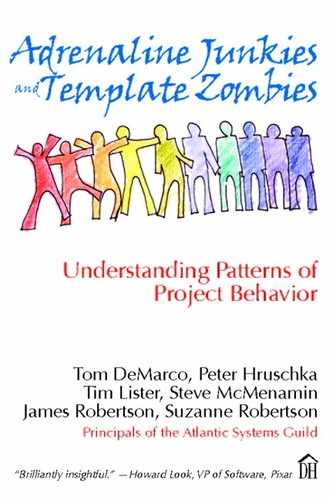56. Undivided Attention
,
Full-time involvement in a single project improves individual performance.
When Derek Jacoby gave his wonderful performance as Alan Turing in the play Breaking the Code, in London’s West End, he worked exclusively on that play for its entire run. Instead of accepting several roles in repertory, he devoted all of his attention and intelligence to that one play. He learned his lines, rehearsed with the other actors, investigated Turing’s life, and determined how he could best portray the great mathematician, logician, and cryptographer. Then he performed the role every night.
The culture of the theater bestows success upon productions with actors such as Derek Jacoby, who devote themselves to one play at a time. We have found that software project cultures often succeed when developers make a similar investment in singular efforts.
Employers hire knowledge workers to take advantage of their ability and brainpower. Suppose you hire a specialist and he has a notional top brainpower production rate of 100 units per hour. As an employer, you want to do everything you can to make sure he operates at his top rate. You do the obvious things to take care of his creature comforts and to create an infrastructure with the tools and assistance necessary to maximize his focused time. Then you assign him to work full-time on a project, and he focuses his brain and works at maximum possible brainpower. Let’s say that he works for 40 hours at top rate—he has given you 4,000 brainpower production units. You are doing everything you can to profit from the brain you have hired.
What you get from this transaction is undivided attention, the product of a positive connection between top brainpower production rate and dedicated work on one project.
Workers who are assigned to multiple, concurrent projects cannot maintain the top brainpower production rate because there is a price, in brainpower units, to pay for multitasking. Switching from the context of project A to project B requires some brainpower for understanding the project B status. Finding all the right project B files, clearing project A thoughts from the mind, reestablishing contact with project B people, and rehashing thoughts that were previously settled—these steps are all necessary for the brain to get reoriented into the context of project B.
“By doing two things at once, you’ve cut your IQ in half, and believe me, those 40 points can really make a difference.”
—Dale Dauten, The New York Times (April 29, 2007).
In the best situation, the loss of productivity is minimized because your worker can call upon coherent and consistent documentation, to help speed up reorientation. But what about knowledge that isn’t documented but is nevertheless clear to people working on the project? To be able to function effectively, the engineer needs to be conscious of previous discussions with customers and management, project meetings, outstanding issues, and many other aspects of the project history. In addition to the time needed to reconnect with the project’s artifacts, there is a time cost in reestablishing personal relationships with other team members. Day-to-day contact between members of the team produces strands of experience that act as a jelling agent. Absent or unreachable team members water down the strength of that jell.
Some have attempted to quantify the cost of context-switching,1 but the multitude of variables involved make estimation difficult. However, based on our observations of human concentration and information transfer, we are confident that context-switching causes a significant decrease in productivity. Organizations that recognize this connection between context-switching and productivity facilitate undivided attention by avoiding assigning an individual to multiple, parallel projects.
1 Gerald Weinberg estimates that the context-switching cost of assigning three projects to one person is 40 percent. In other words, 40 percent of your worker’s time is lost to nonproductive tasks. The other 60 percent is split among the three projects. In a 40-hour week, supposing equal time spent on each project, the worker ends up spending 8 hours on projects A, B, and C, respectively, and a massive 16 hours context-switching. The potential 4,000 brainpower production units is reduced to 2,400. See Gerald M. Weinberg, Quality Software Management, Vol. 1: Systems Thinking (New York: Dorset House Publishing, 1992).
